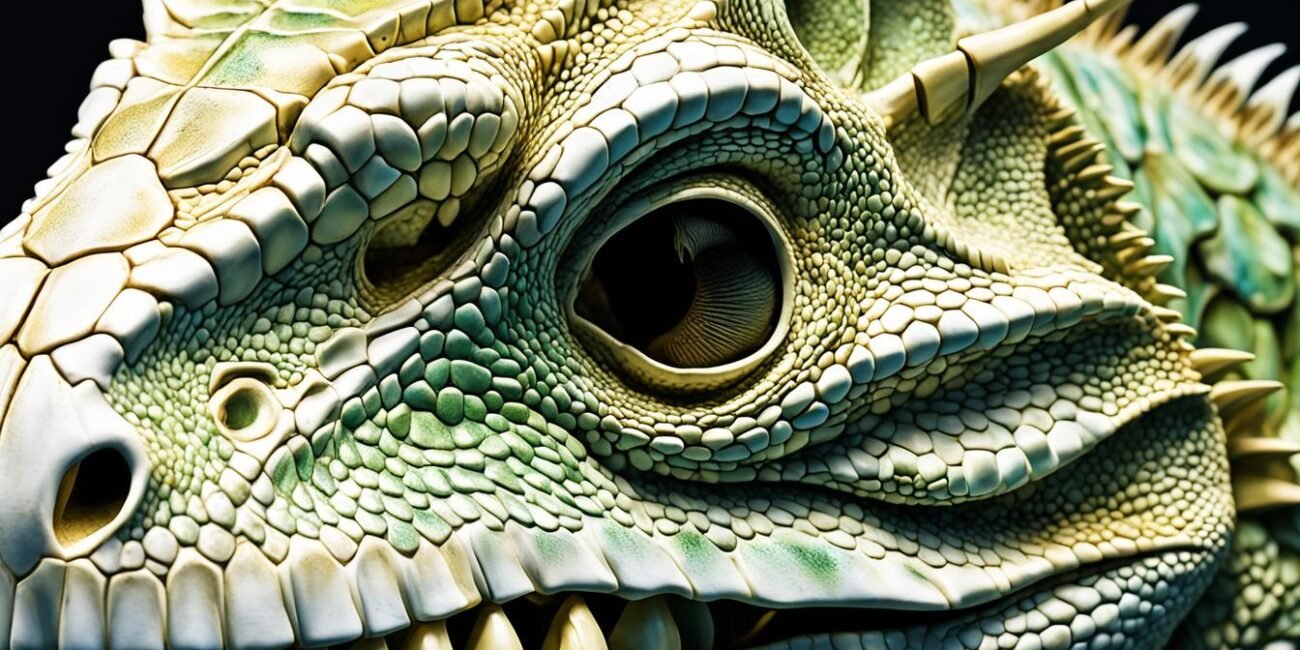As I stood in the lush, tropical landscape, the sun’s rays filtered through the green leaves. I couldn’t help but be drawn to an iguana basking on a nearby rock. These amazing creatures have always fascinated scientists and nature lovers. Their skulls, with their complex structure, show the wonders of evolution.
In this article, we’ll dive into the world of iguana skulls. We’ll look at their role in evolution, their unique features, and how they compare to other reptiles. If you’re into reptiles or just curious, you’ll find this journey fascinating and informative.
Key Takeaways
- Iguanas have evolved a unique skull structure to accommodate their herbivorous diet and lifestyle.
- The iguana skull’s morphology provides insights into the evolutionary adaptations of these remarkable reptiles.
- Comparing iguana skulls to other reptiles reveals both similarities and distinct differences in cranial anatomy.
- Understanding the adaptations of the iguana skull can help us better appreciate the incredible diversity of life on our planet.
- Exploring the fascinating world of iguana skulls can deepen our understanding of reptilian paleontology and comparative anatomy.
Introduction to Iguana Anatomy
Iguanas belong to the Iguanidae family and live in Central and South America, and parts of the Caribbean. They are a diverse group of lizards, adapted to different environments from lush rainforests to dry deserts. Let’s dive into the world of iguana anatomy and see what makes them special.
Overview of Iguana Anatomy
Iguanas can grow up to 110 cm long, making them quite impressive. They have a long, muscular tail, strong limbs, and a dorsal crest on their backs. Their scales overlap for protection and help them regulate their body temperature.
Inside, iguanas have a complex skeleton. This includes a strong skull and many bones that support their functions. Their jaws and teeth are made for eating, and their spine and limbs let them live in trees.
Importance of Understanding Iguanas
Learning about iguana anatomy and biology is key to understanding these amazing reptiles. Some iguanas are invasive in certain areas, while others are endangered. By studying their anatomy, we can learn how to protect them.
This study also helps us understand reptiles better. Iguanas show us how different species adapt and evolve. Their anatomy and physiology give us insights into the diversity of reptiles.
| Iguana Species | Average Length | Geographic Range | Habitat |
|---|---|---|---|
| Green Iguana (Iguana iguana) | 2 meters | Central and South America, Caribbean | Arboreal, near water |
| Rhinoceros Iguana (Cyclura cornuta) | 1.5 meters | Hispaniola (Haiti and Dominican Republic) | Arid, rocky environments |
| Cuban Iguana (Cyclura nubila) | 1.2 meters | Cuba and associated islands | Coastal, rocky areas |
“Iguanas are a diverse and fascinating group of lizards that have adapted to thrive in a wide range of habitats. Understanding their unique anatomy is crucial for conservation efforts and advancing our knowledge of reptile evolution.
Iguana Skull: Nature’s Evolutionary Marvel
The iguana skull shows how these reptiles have changed and adapted over millions of years. It’s a fascinating look into reptile anatomy and how nature selects traits. The iguana skull is a perfect example of this.
Iguanas are part of the Iguanidae family, found in the Americas. Their skulls are strong and have special features for survival. From the iguana skull anatomy to the detailed reptile cranial structure, studying their skulls is very interesting.
The iguana skull can handle tough environments. It has thick bones for protection, especially in the face. This is because iguanas have evolved to live in many places, from dry deserts to green forests.
The squamate fossil record shows that iguanas have been changing their skulls over time. This change helps them survive in different places. Because of this, iguanas have become a big part of reptile life in the Americas.
| Feature | Adaptation |
|---|---|
| Robust Skull Structure | Provides protection and stability in diverse environments |
| Specialized Facial Bones | Enhances feeding and defensive capabilities |
| Lightweight Cranial Design | Supports efficient movement and agility |
| Adaptive Cranial Evolution | Allows iguanas to thrive in changing habitats |
The iguana skull is a great example of nature’s skill. It shows how these reptiles have adapted and survived. By studying iguana skull anatomy, we learn about their evolution and their role in nature.
Comparing Iguana Skulls to Other Reptiles
Understanding how the iguana skull compares to other reptiles is fascinating. By looking at similarities and differences, we learn about their evolution. This helps us see how these creatures have adapted over time.
Similarities and Differences
Iguanas share some traits with other reptiles but their skulls are quite different. Their skulls show how they’ve adapted to different environments and challenges. This makes them stand out from other reptiles.
They share some features with other lizards, like fused bones. But, iguanas have unique traits too. These include special ways of eating and sensing their world.
Evolutionary Traits
The evolution of the iguana skull is a long story of adaptation. Over millions of years, their snouts have grown longer and their skulls have changed. These changes help them survive.
Studies show how iguanas have changed over time. They help us understand the iguana’s unique skull features. This shows us the beauty of their evolution.
“The iguana skull has evolved over millions of years, with its distinct features reflecting the species’ adaptations to various environmental conditions and survival challenges.”
Iguana Skull Morphology: A Closer Look
The iguana skull is a marvel of nature, full of features that help these reptiles live in different places. It has a strong jaw and delicate sensory organs. Each part of the skull is important for its survival and how it lives.
The iguana’s skull has a special skeleton that evolved over millions of years. The iguana skull structure is akinetic, meaning its bones are stuck together. This stops sudden moves that could be dangerous. It’s key for iguanas living in thick plants and rocky places, where they need to move carefully and withstand bumps.
Looking closer, we see iguanas have amazing sensory organs. The parietal eye, a third eye on top of the head, helps them see changes in light and movement. This helps them spot predators.
- The lizard osteology of the iguana skull shows a strong jaw with up to 120 sharp teeth. These are perfect for eating plants.
- The squamate skeletal features include a strong tail that helps with balance. This lets iguanas move quickly and safely, even from high up.
- The iguanid cranial morphology also has a dewlap. This skin flap is for talking and keeping cool, showing how adaptable these reptiles are.
| Iguana Skull Trait | Significance |
|---|---|
| Akinetic Design | Prevents sudden movements, allowing iguanas to navigate tight spaces and withstand impacts |
| Parietal Eye | Detects changes in light and movement, helping iguanas spot predators |
| Robust Jaw Structure | Supports a herbivorous diet with up to 120 sharp, jagged teeth |
| Muscular Tail | Provides counterbalance and aids in agile movements and physical feats |
| Dewlap | Used for communication and temperature regulation |
Looking at the iguana skull morphology shows us how amazing this reptile’s head is. Every part of the skull helps it survive and adapt. It shows how these creatures have evolved to be so unique.
The iguana skull is a true masterpiece of nature, a testament to the remarkable adaptability and resilience of these fascinating reptiles.”
Adaptations of the Iguana Skull
The iguana skull is a true marvel of evolution. It shows many adaptations that help these reptiles live well in different places. These include clever ways to hide and hunt, thanks to their skulls.
Camouflage and Defense Mechanisms
Iguanas are experts at hiding, with their skulls helping them blend in. Their reptile cranial camouflage is amazing. They also have strong skulls for defense against predators.
- Their skulls have special colors and textures to hide in their environment. This makes them hard to see for both predators and prey.
- They have skulls with horns or ridges that can be used for defense.
- They use their tails to scare off or hit predators.
Feeding and Hunting Techniques
The iguana skull is also designed for their eating and hunting ways. It helps them eat plants efficiently. This shows how their skulls have changed to help them find and eat food.
- They have strong jaws and teeth for eating tough plants.
- They have special senses, like the parietal eye, to find food.
- Their skulls are strong and stable for eating.
The iguana skull is a wonder of nature. It shows how these reptiles have adapted to live in different places. Their ability to hide and eat is a testament to nature’s power.
Conclusion: Unlocking the Secrets of Iguana Skulls
As I wrap up my look into the world of iguana skulls, it’s clear they’re full of secrets. These skulls tell us about their evolution and how they’ve adapted over time. They show us the amazing diversity and strength of these reptiles.
By studying the mysteries of the iguana skull, experts and fans can learn a lot. This knowledge helps with conservation and deepens our understanding of nature. The findings from reptile cranial research and lizard bone studies reveal the secrets of iguana anatomy. They also help us understand how these skulls evolved.
Thinking back on this journey, I’m amazed by the importance of the iguana skull. By keeping up the research, we can learn even more about these fascinating reptiles. They teach us a lot about the natural world and our place in it.
FAQ
What are the unique features of the iguana skull?
The iguana skull is a true marvel of nature. It shows the incredible adaptability and resilience of these reptiles. Shaped by millions of years of evolution, the iguana’s skull highlights the species’ ability to live in many environments. Its robust construction and specialized features make it a fascinating study in reptilian anatomy and the power of natural selection.
How does the iguana skull compare to other reptile skulls?
Iguanas share some traits with other reptiles but their skull structure is quite different. These differences help us understand the evolutionary paths of these remarkable creatures. By comparing iguana skulls with those of other lizards, snakes, and crocodilians, we gain deeper insights into their evolution.
What adaptations does the iguana skull exhibit?
Over millions of years, the iguana skull has evolved. Its distinct features show the species’ adaptations to different environments and survival challenges. These adaptations include specialized feeding mechanisms and enhancements to their senses. The evolutionary history of the iguana skull is a fascinating story of nature’s ingenuity.
How does the iguana skull contribute to its survival and lifestyle?
The iguana skull is not just interesting in anatomy but also shows the remarkable adaptations for survival. These adaptations help iguanas blend in with their surroundings and strike back against threats. The iguana skull’s features are a testament to the power of natural selection.
What role does the iguana skull play in its feeding and hunting techniques?
The iguana skull is perfectly suited for the species’ feeding and hunting. Its specialized features let it efficiently gather, process, and consume its plant-based diet. The powerful jaws and unique sensory organs help iguanas find their preferred food sources. These adaptations are crucial for the iguana’s survival and lifestyle.
Source Links
- https://www.livescience.com/61992-iguana-skull-brain-bash-flordia.html – Florida Scientists Are Running Around at Night Bashing in Iguanas’ Skulls
- https://www.kaieteurnewsonline.com/2021/04/18/interesting-creatures-the-iguana/ – Interesting Creatures… The Iguana – Kaieteur News
- https://www.gekkota.com/diapsids/ – Diapsids: Evolution & Diversity of Two-Arched Skull Reptiles
- https://seer.ufu.br/index.php/biosciencejournal/article/download/30045/17769/133591 – Microsoft Word – 25-Agra_30045-vet.doc
- https://www.ncbi.nlm.nih.gov/pmc/articles/PMC10044561/ – Anatomical Description of Rhinoceros Iguana (Cyclura cornuta cornuta) Head by Computed Tomography, Magnetic Resonance Imaging and Gross-Sections
- https://animaldiversity.org/accounts/Iguana_iguana/ – Iguana iguana (Common Green Iguana)
- https://thesea.org/manatee-skeleton/ – Manatee Skeleton
- https://villains.fandom.com/wiki/High_Evolutionary_(Marvel) – High Evolutionary (Marvel)
- https://www.science.gov/topicpages/g/galapagos marine iguana – galapagos marine iguana: Topics by Science.gov
- https://berkeley.pressbooks.pub/morphology/chapter/amphibian-and-reptile-skulls/ – Amphibian and Reptile Skulls
- https://www.ncbi.nlm.nih.gov/pmc/articles/PMC9951731/ – Anatomical Description of Loggerhead Turtle (Caretta caretta) and Green Iguana (Iguana iguana) Skull by Three-Dimensional Computed Tomography Reconstruction and Maximum Intensity Projection Images
- https://www2.clarku.edu/faculty/pbergmann/herpetology/Biol119 Lab 10 – Reptile Osteology.pdf – Microsoft Word – Biol119 Lab 10 – Reptile Osteology.doc
- https://iguanaslife.com/unveiling-the-iguana-a-deep-dive-into-reptile-anatomy/ – Unveiling the Iguana: A Deep Dive into Reptile Anatomy – Iguanas Life
- https://lionandlizard.wordpress.com/iguana/ – The Iguana Skull
- https://www.morphosource.org/concern/media/000068326 – Showcase Media // MorphoSource
- https://www.britannica.com/animal/reptile/Clinging-and-climbing – Reptile – Clinging, Climbing, Adaptations
- https://en.wikipedia.org/wiki/Iguana – Iguana
- https://gamefaqs.gamespot.com/pc/942002-nancy-drew-legend-of-the-crystal-skull/faqs/55520 – Nancy Drew: Legend of the Crystal Skull – Guide and Walkthrough – PC – By myster_nut
- https://www.thegamer.com/animal-well-faq-questions-help-guides/ – Animal Well: FAQ Guide
- https://mysteryscience.com/fossils-tx/mystery-2/fossil-evidence-classification/32 – How do we know what dinosaurs looked like?










No Comment! Be the first one.